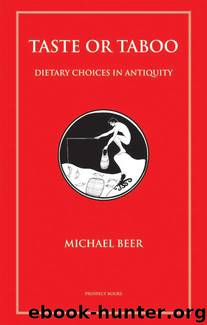Taste or Taboo by Michael Beer

Author:Michael Beer
Language: eng
Format: epub
Tags: COOKING / History
Publisher: Prospect Books
Published: 2010-04-18T16:00:00+00:00
(1) See Williams (2000), 306: ‘...Diasporan Jewry is of far greater relevance to the issues of culture, identity and power in the Roman empire [than the Jews of Judea]’.
(2) Grimm (1996), 20–24; also Grimm (1995), 225–40.
(3) The actual number of fast days in the Jewish calendar are relatively few, commemorating catastrophic or exceptional events in the history of the Jewish people, including the obliteration of the Temples, the fall of Jerusalem, and Yom Kippur, the Day of Atonement; Sigal (1988), 250; Jacobs (1995), 164.
(4) Dillon (2002), 113.
(5) Ar. Thesm. 949; 984. See Detienne (1977), 99–122; Burkert (1985), 242–246; Wilkins and Hill (2006), 97–98.
(6) Ar. Av. 1519.
(7) Plut. De Is. et Os.378E. See also Harrison (1922), 129.
(8) Deut. 14; Levit. 11.
(9) Deut. 14, 6; Levit. 11, 3.
(10) Deut. 14, 4–5.
(11) Deut. 14, 7–8; Levit. 11, 4–8.
(12) Levit. 11, 8.
(13) Levit. 11, 13–19; Deut. 14, 11–18.
(14) Levit. 11, 20–23; Deut 14, 19–20.
(15) Deut. 14, 21. However, Deuteronomy states that it is acceptable to give it to a stranger or sell it to alien peoples.
(16) Levit. 11, 24-40.
(17) Philo The Special Laws IV, 100.
(18) Cf Ath. Deip. 9d.
(19) Philo The Special Laws IV, 102. The two extremes of behaviour are represented by, on one hand, the Spartans and, on the other, the Ionians and the Sybarites.
(20) Diog. Laert. Pythag. VIII.13.
(21) Pl. Resp. III.404bc; Plut. Quaest. conv. IV 4.668F. Ath. Deip. 9d. Philo looks at Moses in a similar way to the way Diogenes Laertius treats Pythagoras and Athenaeus looks at Homer; as a paragon of archaic virtue and as a model for virtuous living.
(22) Philo The Special Laws IV, 105.
(23) Philo The Special Laws IV, 106.
(24) Philo The Special Laws IV, 108–109.
(25) Philo The Special Laws IV, 108–109.
(26) Philo The Special Laws IV, 110–112. This is similar to the hierarchy of animals in the Timaeus. Pl. Ti. 91d–92b; Gilhus (2006), 86.
(27) Philo The Special Laws IV, 113–115.
(28) Philo The Special Laws IV, 116–118.
(29) Philo The Special Laws IV, 119–125.
(30) Hermippus of Smyrna De Pythagora apud: Joseph. Ap. I, 165.
(31) Plut. Quaest. Rom. 268.
(32) Douglas (1966), 54–72.
(33) Douglas (1966), 56.
(34) Douglas (1966), 61–2.
(35) Douglas (1966), 63.
(36) Neusner (1975), 21.
(37) Cohen (1993), 1–45.
(38) Cohen (1993), 8.
(39) Philo In Flacc. 55.
(40) Hdt. II.36; 104. Also Goldstein (1939), 356. Initially, he states that they were the only proponents of this custom, but later modifies this, stating that other races, such as the Ethiopians and the Colchians, adopted the practice, with the Phoenicians and the Syrians of Palestine following suit.
(41) Hor. Sat. I, 9:70. Mart. Epig. VII,30:5. Mart. Epig. VII,35:3–4. Mart. Epig.VII, 82:6.
(42) Tac. Hist. V, 5:2.
(43) See Athanassiadi and Frede (2001). A conference on this topic was held at the University of Exeter 17–20 July 2006. A publication is forthcoming.
(44) Zuesse (1974), 21.
(45) Joseph Ap. 2.282.
(46) See Dalby (2003), 268–9; Wilkins and Hill (2006), 147–149 for the importance of the pig in Graeco-Roman culture.
(47) Plut. Cic. 7.5.
(48) Macrob. Sat. 2.4.11.
(49) Juv. Sat. XIV, 98. A similar remark is made by Galen; Gal. de al. fac. K663. Galen’s
Download
This site does not store any files on its server. We only index and link to content provided by other sites. Please contact the content providers to delete copyright contents if any and email us, we'll remove relevant links or contents immediately.
| Culinary Biographies | Essays |
| Food Industry | History |
| Reference |
A Court of Wings and Ruin by Sarah J. Maas(7651)
The Death of the Heart by Elizabeth Bowen(3552)
The Sprouting Book by Ann Wigmore(3543)
Better Homes and Gardens New Cookbook by Better Homes & Gardens(3525)
BraveTart by Stella Parks(3395)
Salt, Fat, Acid, Heat: Mastering the Elements of Good Cooking by Nosrat Samin(3108)
Sauces by James Peterson(3051)
Kitchen confidential by Anthony Bourdain(3009)
The Bread Bible by Rose Levy Beranbaum(3004)
Classic by Mary Berry(2942)
Solo Food by Janneke Vreugdenhil(2929)
Ottolenghi - The Cookbook by Yotam Ottolenghi(2871)
Martha Stewart's Baking Handbook by Martha Stewart(2796)
Day by Elie Wiesel(2720)
Betty Crocker's Good and Easy Cook Book by Betty Crocker(2680)
The Plant Paradox by Dr. Steven R. Gundry M.D(2547)
My Pantry by Alice Waters(2546)
The Kitchen Counter Cooking School by Kathleen Flinn(2486)
Hot Sauce Nation by Denver Nicks(2451)
